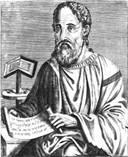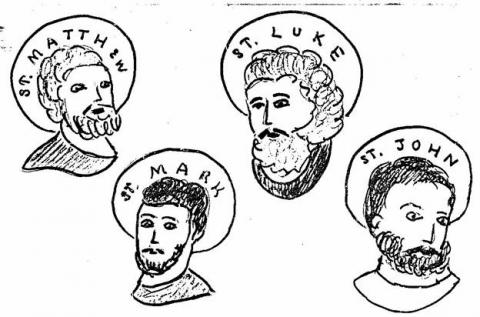Canon of Scripture
CANON OF SCRIPTURE
Objectives:
- Students should know how we got our Bible.
- Students should know the word “Canon” and what it means.
- Students should memorize the names of the 4 gospels plus the book of Acts.
Possible Lesson Plan:
- Open with prayer.
- How did we get the Bible? In the early Church, the only Scriptures known were the
Old Testament or Hebrew Scriptures. It was written in their language, Hebrew. It was written long before Jesus was born. The Hebrew Scriptures tell about the creation of the world, God’s chosen people, God’s promises of a Savior, and the history of the Jewish people. Do you remember some of the stories from the Old Testament? Some of the books we memorized 2 years ago? Jesus Himself read from these Scriptures when He taught. This was the only Bible read by the apostles! Look at the Old Testament in your Read with Me Bibles.
In the first days after Pentecost, the apostles taught the people about Jesus. The people memorized the stories and loved hearing them. So, even while the apostles were still alive, collections of stories about Jesus began to be written down. Peter probably supervised the writing of the gospel of Mark. Luke traveled and talked to many people to learn all about Jesus to write his gospel. And, of course, Matthew and John were with Jesus from the start and wrote what they had personally seen and heard. These books are called the gospels and tell about Jesus. They are the first four books of the New Testament.
Luke also traveled with Paul and wrote a book about the history of the early Church. This is called the book of Acts. The apostles traveled to many cities, starting churches all over the world. When you travel, don’t you send letters or postcards to those you miss at home or in other towns? So, the apostles wrote letters, or epistles, to others of their churches while they were elsewhere. Most were written in Greek. Paul, Peter, John, James, and Jude all wrote letters. In fact, they wrote a lot more letters than are in the New Testament. Some letters may have been fake or lies. But, from earliest times, certain ones of their letters went from church to church, copy by copy, by foot or donkey or horse or camel. Each copy was made by hand – each hand-carried with love to the next town to share with fellow believers. Even the apostles, in their letters, talked about the letters of the other apostles they had read! These letters were especially precious in the days of persecution, when they had to be hidden carefully from the Romans. In fact, during the reign of Diocletian, the Romans sent spies all over the empire and tried to destroy all Christian writings!
 But, by the second century, many of these letters were well-known through the church. Early Christian bishops, Clement and Polycarp and Ignatius (Do you remember the story of Polycarp?), refer to them as being read in the churches. Finally, Constantine became Emperor and Christians were free to read the Scriptures in their churches openly. But, which Scriptures? Constantine gave the great historian Eusebius, who had lived through the persecution of Diocletian, a great order – to produce 50 Bibles. Eusebius carefully studied all the letters and gospels he could find and came up with a list of 27 books for the New Testament, the same 27 books we recognize today. Can you count to 27? The first are the gospels (Can you name them?), then the Acts, then lots of epistles (or letters), and finally the Revelation of John (Remember what it was about?).
But, by the second century, many of these letters were well-known through the church. Early Christian bishops, Clement and Polycarp and Ignatius (Do you remember the story of Polycarp?), refer to them as being read in the churches. Finally, Constantine became Emperor and Christians were free to read the Scriptures in their churches openly. But, which Scriptures? Constantine gave the great historian Eusebius, who had lived through the persecution of Diocletian, a great order – to produce 50 Bibles. Eusebius carefully studied all the letters and gospels he could find and came up with a list of 27 books for the New Testament, the same 27 books we recognize today. Can you count to 27? The first are the gospels (Can you name them?), then the Acts, then lots of epistles (or letters), and finally the Revelation of John (Remember what it was about?).
Add Eusebius of Caesarea to your timeline.
- Feed the Elephant True/False Questions:
True False
The Old Testament was written in Hebrew. The New Testament was written in Hebrew.
The Gospels tell of the life of Jesus The Acts tell of the life of Jesus.
Epistles are letters. Epistles are made of chewing gum.
There are 27 books in the New Testament. There are 100 books in the New Testament.
The Revelation is the last book of the Bible. Genesis is the last book of the Bible.
- Work on the books of the Bible – even the smallest children should be able to say the names of the gospels and know what a gospel is. Memory work for this week is the books of the Bible for the older classes; the smallest children need only know “Matthew, Mark, Luke, John, Acts” to get their prize. Look thru their Bible storybooks, showing the Old Testament, the gospels, the Acts. Let them see a “real” Bible and look through it as well. Repeat the word “canon” a few times; this is the list of books that the Church, throughout holy tradition, has accepted as the word of God.
Each Gospel has a symbol in the church: St. Matthew a man or angel, St. Mark a lion or winged lion, St. Luke an ox or winged ox, and St. John an eagle. Begin to learn the names of the gospels by doing each symbol in fingerpaint on light blue paper, with white, yellow, and brown fingerpaints, using hands, feet, and fingers to make the figures.
- Alternate Craft Idea: Make a “Bible”: Fold a piece of construction paper in half to make a “book”. On the cover, put the 4 evangelists with the words “Holy Bible” at the top and a cross in the center. On the inside, paste a copy of the Bible Bookcase, with the Old Testament on one side and the New Testament on the other. Color the evangelists.

- Close with prayer: Lord, may I read your Holy Bible every day of my life.